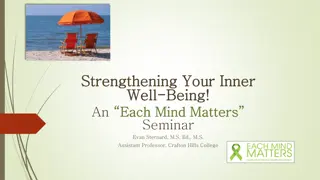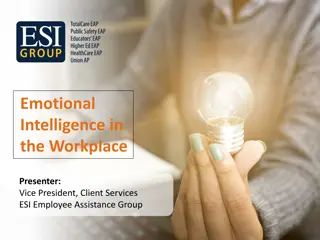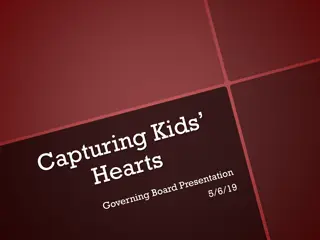Exploring Social and Emotional Learning for Families
Understanding the importance of social and emotional learning in family life, this resource provides insights on developing key skills, fostering growth, and creating a supportive community. Discover what SEL is, its benefits, and dispelling common misconceptions. Explore learning agreements, session objectives, and practical tips for nurturing social and emotional skills at home.
Download Presentation

Please find below an Image/Link to download the presentation.
The content on the website is provided AS IS for your information and personal use only. It may not be sold, licensed, or shared on other websites without obtaining consent from the author. Download presentation by click this link. If you encounter any issues during the download, it is possible that the publisher has removed the file from their server.
E N D
Presentation Transcript
PTA Healthy Minds: Building Social and Emotional Skills at Home For Middle Schools PTA.org/HealthyLifestyles
Lets get to know each other! Please share this information: 1. Name 2. Student s grade level(s) 3. One moment with your teen over the last year that made you laugh out loud 4. One moment with your teen over the last year in which you felt extremely proud PTA.org/HealthyLifestyles
Learning Agreements What do we need to agree to that can help us ensure we learn together in a safe, caring environment? PTA.org/HealthyLifestyles
What You Will Need Please be sure you have: 1. Notebook or paper 2. Pen or pencil PTA.org/HealthyLifestyles
Session Objectives 1. Discover what social and emotional learning is and why it s important 2. Learn about key social and emotional skills and how to foster their development in family life 3. Reflect on our own family lives, how this lens already fits in, and ways in which we can use it to enhance our support of all family members 4. Discuss with and learn from one another creating a safe, supportive learning community PTA.org/HealthyLifestyles
What is Social Emotional Learning? Social and emotional learning involves critical life skills like knowing and understanding your own emotions, strengths, and limitations, understanding and communicating with others, learning from diverse perspectives, working through problems and making responsible decisions. Collaborative for Academic, Social and Emotional Learning (CASEL), 2022 PTA.org/HealthyLifestyles
What SEL IS and what it is NOT SEL is NOT... SEL IS...... It boosts academic performance and deepens engagement with content A distraction from academics Therapy It builds relationships and skills that builds healthy wellbeing A way to teach students a particular political agenda or set of values It helps students understand different perspectives and share ideas A one-size-fits-all approach It is shaped by local priorities of families, schools and communities PTA.org/HealthyLifestyles
Why is social and emotional learning important for your children? How is it important to you as a parent/caregiver? PTA.org/HealthyLifestyles
Why is SEL Important? Learning takes place because of safe, caring relationships. Memory is sealed in by emotions. Social and emotional skills are vital in every aspect of academic success. A strong research base supports these statements. Durlak et al. (2011). The impact of enhancing students social and emotional learning: A meta-analysis of school- based interventions. Child Development, 82, 405-432. PTA.org/HealthyLifestyles
Each and every family culture is unique. There is no one way, no right way. PTA.org/HealthyLifestyles
Hopes and Dreams What are your hopes and dreams for your student? What are your hopes and dreams for your role as a parent/ caregiver? PTA.org/HealthyLifestyles
How Hopes and Dreams Align with Skills Miller, Wanless, & Weissberg. (2018). Parenting for competence and parenting with competence: Essential connections between parenting and social and emotional learning. The School Community Journal, 28(2), 9-28. PTA.org/HealthyLifestyles
SEL at Home A sixth grader is working on her empathy skills when she misinterprets a friend s glare as anger toward her when her anger actually relates to a family problem. A seventh grader struggles with anxiety at test-taking time as he exercises his healthy coping skills. An eighth grader is bullied by a popular student. He learns how to stand his ground in a safe way in which no one gets hurt while seeking support from an understanding friend. PTA.org/HealthyLifestyles
Your Challenge What challenge are you facing with your tween or teen right now? PTA.org/HealthyLifestyles
Self Awareness Our understanding of our inner thoughts, feelings, and values and how they impact our choices. It involves a sense of our strengths and limitations and our growing identity. PTA.org/HealthyLifestyles
Self Management Our ability to manage our emotions and impulses and set and persist toward goals that are aligned with meeting our needs, values and desires. PTA.org/HealthyLifestyles
Social Awareness The degree to which we are able to empathize with the thoughts and feelings of others, particularly those who are from different races, cultures, backgrounds and contexts as well as our ability to take social cues to inform our communication and choices. PTA.org/HealthyLifestyles
Relationship Skills Our ability to create and sustain healthy relationships with others by communicating effectively (verbally, in writing and nonverbally), listening, demonstrating cultural competence, collaborating and resolving conflicts constructively. PTA.org/HealthyLifestyles
Responsible Decision Making Our ability to make a reflective choice that advances us toward a goal while considering the impact (trying to do no harm) on individuals, groups, organizations or the environment in the short and long term while accepting any consequence of that decision. PTA.org/HealthyLifestyles
How are Social and Emotional Skills Developed? AT HOME AND EVERYWHERE IN RELATIONSHIP OVER TIME PTA.org/HealthyLifestyles
What can families do to foster social and emotional skill growth and development? PTA.org/HealthyLifestyles
Lets try it! Real Life Scenario: As a parent, how do you feel? Your sixth grader is cranky and snappish when she arrives home from school. She throws down her backpack and runs to her room. Is she hungry? Exhausted? Did she get bullied at school? Was her teacher strict with her? You have a million questions and no answers. She has firmly shut the door and doesn t want to talk. What social and emotional skills are being tested in you? What social and emotional skills do you have the opportunity to promote in your tween/teen? What are ways in which you can respond to transform this moment into a skill-building opportunity? PTA.org/HealthyLifestyles
Every parenting challenge offers an opportunity to build a social and emotional skill in our tween or teen and in ourselves if we pause and ask ourselves what opportunity exists in this moment? PTA.org/HealthyLifestyles
Personal Goal Setting Setting a positive goal is an important social and emotional skill. Take a moment to set your own personal goal for responding to challenges in ways that can build social and emotional skills. What do you intend to try? Be specific! PTA.org/HealthyLifestyles
Keep Learning! PTA.org/SocialEmotional Find information on what SEL skills are and how they can be strengthened Tools to help your family build social and emotional skills Links to other organizations tools like those from CASEL (Collaborative for Academic, Social and Emotional Learning) and Confident Parents, Confident Kids PTA.org/HealthyLifestyles
Takeaways What is one key learning you are taking away? PTA.org/HealthyLifestyles
We value your thoughts! PTA.org/Survey Please spend a few minutes taking this survey to let us know what you thought of this session and how you think we could improve it. PTA.org/HealthyLifestyles
An atmosphere that provides support for one s social and emotional learning is equal to the difference in the outcome of throwing seeds on cement versus enriched soil. And what a difference that is! James Comer, Yale Child Study Center PTA.org/HealthyLifestyles























